Choosing a Gaming CPU October 2013: i7-4960X, i5-4670K, Nehalem and Intel Update
by Ian Cutress on October 3, 2013 10:05 AM ESTFor an article like this getting a range of CPUs, which includes the most common and popular, is very important. I have been at AnandTech for just over two years now, and in that time we have had Sandy Bridge, Llano, Bulldozer, Sandy Bridge-E, Ivy Bridge, Trinity and Vishera, of which I tend to get supplied the top end processors of each generation for testing (as a motherboard reviewer, it is important to make the motherboard the limiting factor). A lot of users have jumped to one of these platforms, although a large number are still on Wolfdale (Core2), Nehalem, Westmere, Phenom II (Thuban/Zosma/Deneb) or Athlon II. I have attempted to pool all my AnandTech resources, contacts, and personal resources, together to get a good spread of the current ecosystem, with more focus on the modern end of the spectrum. It is worth nothing that a multi-GPU user is more likely to have the top line Ivy Bridge, Vishera or Sandy Bridge-E CPU, as well as a top range motherboard, rather than an old Wolfdale. As time progresses I hope to obtain greater ranges of CPU speeds, core counts, and caches to suit almost all tastes.
The CPUs
My criteria for obtaining CPUs was to use at least one from the most recent architectures, as well as a range of cores/modules/threads/speeds. The basic list as it stands is shown below, with the CPU.GPU on the left showing what we were able to test:
| VIA | |||||||||
| CPU | GPU | Name | IGP | Socket | C / M (T) | Speed | Turbo | L2/L3 | |
|---|---|---|---|---|---|---|---|---|---|
| L2007 | Nano | BGA400 | 1 (1) | 1600 | 1 MB / - | ||||
| AMD | |||||||||
| CPU | GPU | Name | IGP | Socket | C / M (T) | Speed | Turbo | L2/L3 | |
| E-350 | Fusion | FT1 | 2 (2) | 1600 | 1 MB / - | ||||
| A6-3650 | Llano | FM1 | 4 (4) | 2600 | 4 MB / - | ||||
| A8-3850 | Llano | FM1 | 4 (4) | 2900 | 4 MB / - | ||||
| A8-5600K | Trinity | FM2 | 2 (4) | 3600 | 3900 | 4 MB / - | |||
| A10-5800K | Trinity | FM2 | 2 (4) | 3800 | 4200 | 4 MB / - | |||
| A6-5200 | Kabini | FT3 | 4 (4) | 2000 | 2 MB / - | ||||
|
Phenom II X2-555 BE |
Callisto K10 | AM3 | 2 (2) | 3200 | 1 MB / 6 MB | ||||
|
Phenom II X4-960T |
Zosma K10 | AM3 | 4 (4) | 3200 | 2 MB / 6 MB | ||||
|
Phenom II X6-1100T |
Thuban K10 | AM3 | 6 (6) | 3300 | 3700 | 3 MB / 6 MB | |||
| FX-8150 | Bulldozer | AM3+ | 4 (8) | 3600 | 4200 | 8 MB / 8 MB | |||
| FX-8350 | Piledriver | AM3+ | 4 (8) | 4000 | 4200 | 8 MB / 8 MB | |||
| Intel | |||||||||
| CPU | GPU | Name | IGP | Socket | C / M (T) | Speed | Turbo | L2/L3 | |
| E6400 | Conroe | 775 | 2 (2) | 2133 | 2 MB / - | ||||
| E6550 | Conroe | 775 | 2 (2) | 2333 | 4 MB / - | ||||
| E6700 | Conroe | 775 | 2 (2) | 2667 | 4 MB / - | ||||
| Q9400 | Yorkfield | 775 | 4 (4) | 2667 | 6 MB / - | ||||
|
Core i7-920 |
Nehalem | 1366 | 4 (8) | 2667 | 2933 | 1 MB / 8 MB | |||
|
Core i7-950 |
Nehalem | 1366 | 4 (8) | 3067 | 3333 | 1 MB / 8 MB | |||
|
Core i7-990X |
Westmere | 1366 | 6 (12) | 3467 | 3733 | 1.5 MB / 12 MB | |||
|
Xeon X5690 |
Westmere | 1366 | 6 (12) | 3467 | 3733 | 1.5 MB / 12 MB | |||
|
2 x Xeon X5690 |
Westmere | 1366 | 12 (24) | 3467 | 3733 | 1.5 MB / 12 MB | |||
|
Celeron 847 |
Sandy Bridge ULV |
BGA1023 | 2 (2) | 1100 | 0.5 MB / 2 MB | ||||
|
Celeron G465 |
Sandy Bridge |
1155 | 1 (2) | 1900 | 0.25 MB / 1.5 MB | ||||
|
Core i5-2500K |
Sandy Bridge |
1155 | 4 (4) | 3300 | 3700 | 1 MB / 6 MB | |||
|
Core i7-2600K |
Sandy Bridge |
1155 | 4 (8) | 3400 | 3800 | 1 MB / 8 MB | |||
|
Core i7-3930K |
Sandy Bridge-E |
2011 | 6 (12) | 3200 | 3800 | 1.5 MB / 12 MB | |||
|
Core i7-3960X |
Sandy Bridge-E |
2011 | 6 (12) | 3300 | 3900 | 1.5 MB / 15 MB | |||
|
2 x Xeon E5-2690 |
Sandy Bridge-EP |
2011 | 16 (32) | 2900 | 3800 | 2 MB / 20 MB | |||
|
4 x Xeon E5-4650L |
Sandy Bridge-EP |
2011 | 32 (64) | 2600 | 3100 | 2 MB / 20 MB | |||
|
Core i3-3225 |
Ivy Bridge | 1155 | 2 (4) | 3300 | 0.5 MB / 3 MB | ||||
|
Core i7-3770K |
Ivy Bridge | 1155 | 4 (8) | 3500 | 3900 | 1 MB / 8 MB | |||
|
Core i7-4960X |
Ivy Bridge-E | 2011 | 6 (12) | 3600 | 4000 | 1.5 MB / 15 MB | |||
|
Core i5-4430 |
Haswell | 1150 | 4 (4) | 3000 | 3200 | 1 MB / 6 MB | |||
|
Core i5-4670K |
Haswell | 1150 | 4 (4) | 3400 | 3800 | 1 MB / 6 MB | |||
|
Core i7-4770K |
Haswell | 1150 | 4 (8) | 3500 | 3900 | 1 MB / 8 MB | |||
|
Core i7-4750HQ |
Haswell + Crystalwell |
BGA1364 | 4 (8) | 2000 | 3200 |
1 MB / 6 MB 128 MB L4 |
|||
|
Xeon E3-1280 V3 |
Haswell | 1150 | 4 (8) | 3600 | 4000 | 1 MB / 8 MB | |||
|
Xeon E3-1285 V3 |
Haswell | 1150 | 4 (8) | 3600 | 4000 | 1 MB / 8 MB | |||
Note: the indication on the left hand side is whether we have tested the CPU in terms of our CPU tests or our GPU tests. In certain circumstances GPU tests were unavailable, but the CPU tests provide interesting data points.
This is Part 2 of our Gaming CPU series, with Part 1 covering a basic range of CPUs and a Haswell update covering the i7-4770K. For Part 2 this is primarily an Intel 4670K/Nehalem update, whereas Part 3 of our testing will focus on the AMD side. I currently have many AMD CPUs in house (Richland, Trinity, K10) and am on the request list for a few more (Vishera, more Richland).
The GPUs
My first and foremost thanks go to both ASUS and ECS for supplying me with these GPUs for my test beds. They have been in and out of 60+ motherboards without any issue, and will hopefully continue. My usual scenario for updating GPUs is to flip AMD/NVIDIA every couple of generations – last time it was HD5850 to HD7970, and as such in the future we will move to a 7-series NVIDIA card or a set of Titans (which might outlive a generation or two).
The ASUS HD 7970 we use is the reference model at the 7970 launch, using GCN architecture, 2048 SPs at 925 MHz with 3 GB of 4.6 GHz GDDR5 memory. We had four cards to be used in 1x, 2x, 3x and 4x configurations where possible, also using PCIe 3.0 when enabled by default, although for this update we were limited to three.
ECS GTX 580 (NGTX580-1536PI-F)
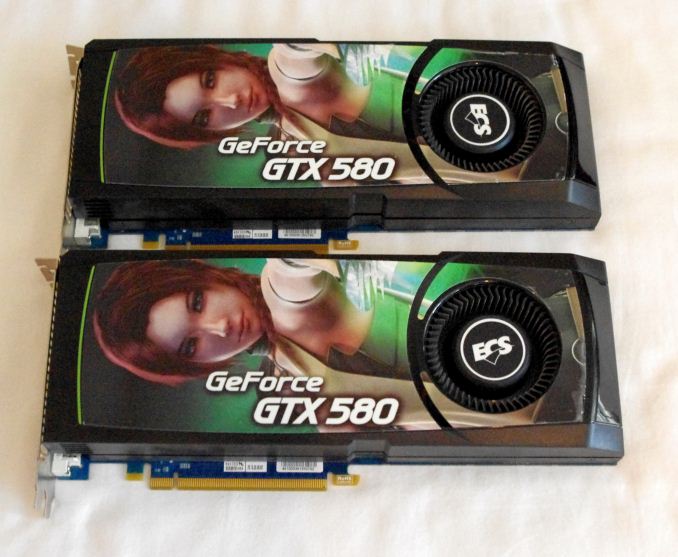
ECS is both a motherboard manufacturer and an NVIDIA card manufacturer, and while most of their VGA models are sold outside of the US, some do make it onto e-e-tailers like Newegg. This GTX 580 is also a reference model, with 512 CUDA cores at 772 MHz and 1.5 GB of 4 GHz GDDR5 memory. We have two cards to be used in 1x and 2x configurations at PCIe 2.0.
The Motherboards
The CPU is not always the main part of the picture for this sort of review – the motherboard is equally important as the motherboard dictates how the CPU and the GPU communicates with each other, and what the lane allocation will be. As mentioned on the previous page, there are 20+ PCIe configurations for Z87/Z77 alone when you consider some boards are native, some use a PLX 8747 chip, others use two PLX 8747 chips, and about half of the Z87/Z77 motherboards on the market enable four PCIe 2.0 lanes from the chipset for CrossFireX use (at high latency). We have tried to be fair and take motherboards that may have a small premium but are equipped to deal with the job. As a result, some motherboards may also use MultiCore Turbo, which as we have detailed in the past, gives the top turbo speed of the CPU regardless of the loading.
As a result of this lane allocation business, each value in our review will be attributed to both a CPU, whether it uses MCT, and a lane allocation.
| Motherboards | |||
|---|---|---|---|
| Socket | Chipset | Motherboard | PCIe |
| 1150 | Z87 |
ASUS Z87-Pro  |
PCIe 3.0 x8/x8 + PCIe 2.0 x4 |
MSI Z87-GD65 Gaming  |
PCIe 3.0 x8/x8/x4 | ||
GIGABYTE Z87X-UD3H  |
PCIe 3.0 x8/x8 + PCIe 2.0 x4 | ||
MSI Z87 XPower  |
PCIe 3.0 x8/x8/x8/x8 via PLX8747 | ||
| 1155 | Z77 |
ASUS Maximus V Formula  |
PCIe 3.0 x8/x4/x4 |
GIGABYTE Z77X-UP7  |
PCIe 3.0 x8/x8/x8/x8 via PLX8747 | ||
GIGABYTE G1.Sniper M3  |
PCIe 3.0 x8/x8 or x16 + PCIe 2.0 x4 | ||
| 2011 | X79 |
ASRock X79 Professional  |
PCIe 2.0 x16/x8/x8/x8 |
ASUS Rampage IV Extreme  |
PCIe 3.0 x16/x8/x8/x8 | ||
Gigabyte X79-UD3  |
PCIe 3.0 x16/x8/x8/x8 | ||
| 1366 | X58 |
GIGABYTE X58A-UD9  |
PCIe 2.0 x16/x16/x16/x16 via NF200 |
ASRock X58 Extreme3 .jpg ) |
PCIe 2.0 x16/x16 + x4 | ||
| 5520 |
EVGA SR-2  |
PCIe 2.0 x16/x16/x16/x16 via NF200 | |
| 775 | 975X |
MSI Platinum Power Up  |
PCIe 1.1 x8/x8 |
| P965 |
ASUS Commando  |
PCIe 1.1 x16 + x4 | |
| FM1 | A75 |
GIGABYTE A75-UD4H  |
PCIe 2.0 x8/x8 |
ASRock A75 Extreme6  |
PCIe 2.0 x8/x8 + x4 | ||
| FM2 | A85X |
GIGABYTE F2A85X-UP4  |
PCIe 2.0 x8/x8 + x4 |
| AM3 | 990FX |
ASUS Crosshair V Formula  |
PCIe 2.0 x16/x8/x8 |
| BGA400 | VX900 |
ECS VX900-I  |
N/A |
| BGA1023 | NM70 |
ECS NM70-I2  |
N/A |
| FT3 | A6-5200 |
ASRock IMB-A180-H .jpg ) |
N/A |
The Memory
Our good friends at G.Skill are putting their best foot forward in supplying us with high end kits to test. The issue with the memory is more dependent on what the motherboard will support – in order to keep testing consistent, no overclocks were performed. This meant that boards and BIOSes limited to a certain DRAM multiplier were set at the maximum multiplier possible. In order to keep things fairer overall, the modules were adjusted for tighter timings. All of this is noted in our final setup lists.
Our main memory testing kit is our trusty G.Skill 4x4 GB DDR3-2400 9-11-11 1.65 V RipjawsX kit which has been part of our motherboard testing for over twelve months. For times when we had two systems being tested side by side, a G.Skill 4x4 GB DDR3-2400 10-12-12 1.65 V TridentX kit was also used.
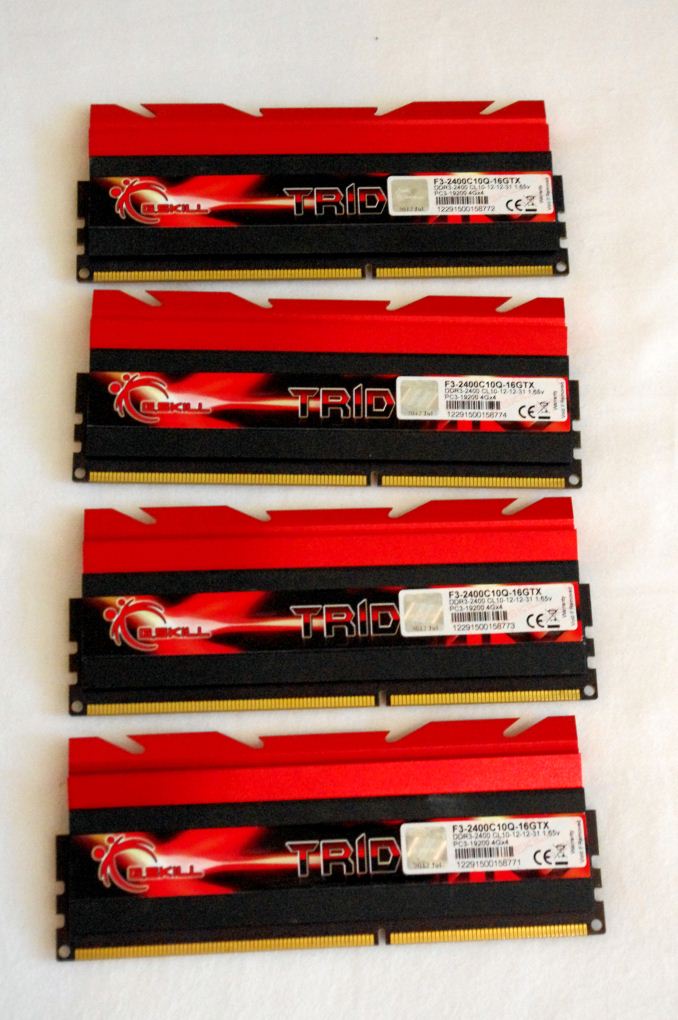
For The Beast, which is one of the systems that has the issue with higher memory dividers, we pulled in a pair of tri-channel kits from X58 testing. These are high-end kits as well, currently discontinued as they tended to stop working with too much voltage. We have a sets of 3x2 GB OCZ Blade DDR3-2133 8-9-8 and 3x1 GB Dominator GT DDR3-2000 7-8-7 for this purpose, which we ran at 1333 6-7-6 due to motherboard limitations at stock settings.
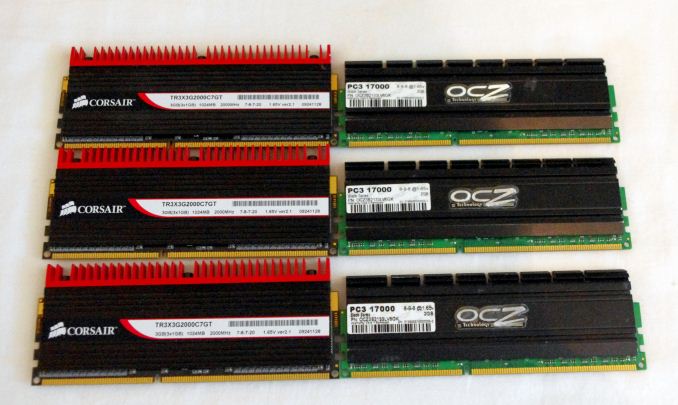
Our Core2Duo CPUs clearly gets their own DDR2 memory for completeness. This is a 2x2 GB kit of OCZ Platinum DDR2-666 5-5-5.
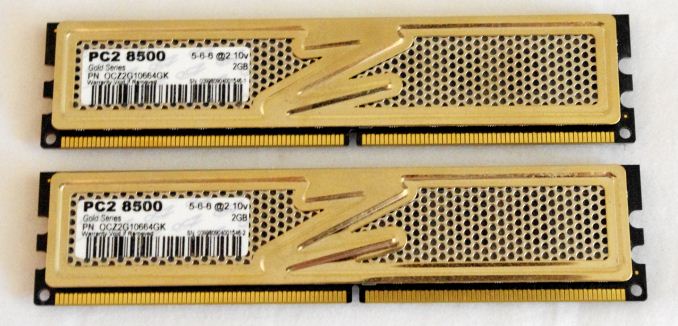
For Haswell we were offered new kits for testing, this time from Corsair and their Vengeance Pro series. This is a 2x8 GB kit of DDR3-2400 10-12-12 1.65 V.


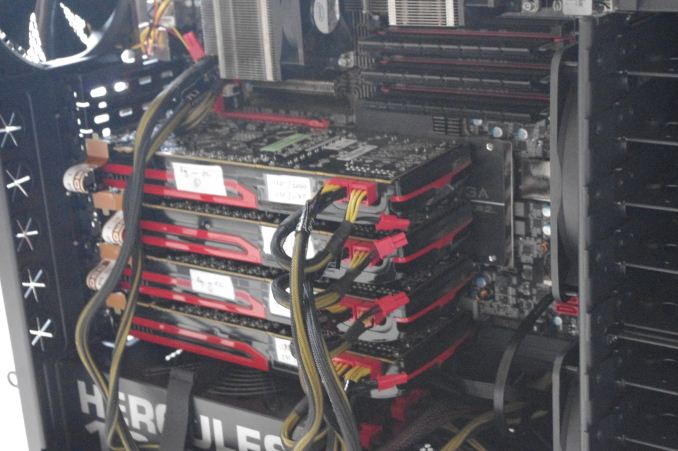
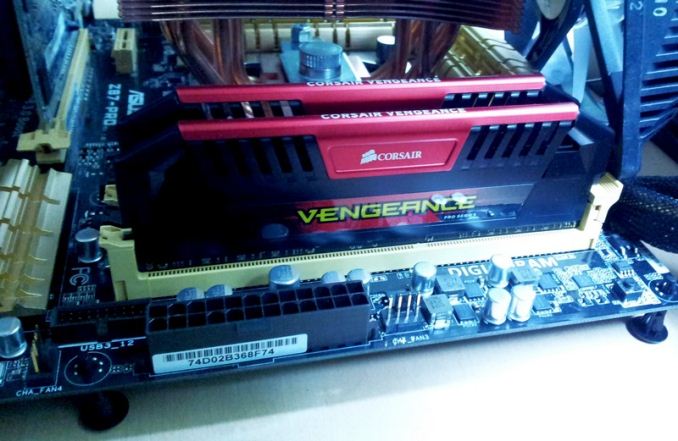








137 Comments
View All Comments
Ranger101 - Friday, October 4, 2013 - link
Every time an article of this sort is written, the conclusion is the same. In the vast majority of cases, due to GPU bottlenecks, the performance differences between CPUs are so minimal that no-one would notice the difference in game. Yawn.This is the 3rd time I am posting this comment as it seems to be continually removed. Yet it is a legitimate and non offensive comment. What happened to freedom of expression at Anandtech?
Flunk - Friday, October 4, 2013 - link
I'm seeing all three of your postsdingetje - Friday, October 4, 2013 - link
would be nice to see how the haswell pentiums (like the g3420) do as low budget low power gaming cpu.too bad none of the review sites so far have deemed them worthy of a review so far.
geok1ng - Friday, October 4, 2013 - link
"Of course we would suggest Haswell over Ivy Bridge based on Haswell being that newer platform."If only Haswell OCs were equal to IB OCs. With Haswell you are STUCK at 4.2-4.6Ghz, depending on your luck, and going water wont help. With IB 4.4-5.0Ghz in usual, and the more money you invest in cooling , the better will be your OC. This luck of the draw in Haswell, and the walls in OCing at Z87 should be considered, especially at triple and quad GPU builds aiming at 4k gaming, where a bad overclock is the doom of the entire system.
coachingjoy - Friday, October 4, 2013 - link
good job, like your work.meliketrolls - Friday, October 4, 2013 - link
Of course AMD CPUs will have better scores. It's just that... AMD is WAAAAY better than Intel.R-Type - Friday, October 4, 2013 - link
I have a Dell XPS 420 with Q6600. With the 8800GT (512 MB) card I was getting about 40 fps with medium settings. When I upgraded to a GTX 670, I got about 60 FPS with high settings, a very noticeable improvement. In my experience, a quad core Q6600 is still a pretty competent gamer with a strong graphics card on all but the most extreme games.R3dox - Friday, October 4, 2013 - link
I'm one of those with a D0 i7 920 and it's been running at 3.8GHz (19x200bclk with 'only' 1600C9 memory, 12GB) for over 4 years. I suppose I'll just have to wait for a nice native PCIe SSD to avoid the old SATA controller and I'm golden for a good while more. It's just my HD6970 that could use replacement at some point (1920x1200 reso, nothing crazy).BOMBOVA - Friday, October 4, 2013 - link
for my x58, i put in one of these "" SYBA SI-PEX40057 PCI-Express 2.0 "" fifty bucks, makes the newer ssd's rock, i am still happy with my platform and video work, and jpg work, is flash twice as good. " we love our i7-920"s " Cheers, good thread this, all power users, / good funR3dox - Sunday, October 6, 2013 - link
When I upgraded to my current intel 520( due to being 3x bigger than previous ssd), I looked into such cards but they were pretty bad and except for sequencial 128kb read, slower than the intel sata controller. I see this is a new version of the marvell controller but is it actually comparable to an intel sata 3 controller this time?